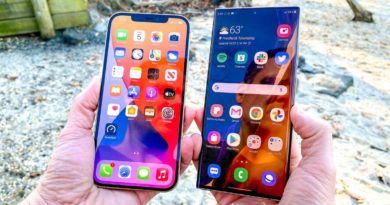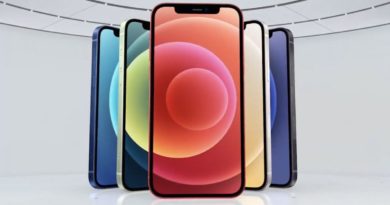iOS 14: Release date, beta, features and news
![]()
We’ve gotten our first official look at what Apple has planned for iOS 14, and this is no ordinary update.
While you’ll find the usual array of tweaks and enhancements in this update to the software that powers Apple’s iPhones, iOS 14 introduces totally new ways to interact with the apps you know and love — whether you’re using it on one of Apple’s upcoming iPhone 12 models or you install the update on the iPhone you currently own.
You’re in for a little wait for a final version of iOS 14, which won’t arrive until later this year (though a public beta is on the horizon). Still, now that we’ve seen a preview of iOS 14, we have a better sense of the new ways we’ll interact with our iPhones, the updated app features at our fingertips and the entirely new additions Apple has planned.
Here’s what we know so far about iOS 14 and what it means for the iPhone.
iOS 14 release date
We don’t have an official iOS 14 release date yet — Apple keeps that information pretty close to the vest. But going by past iOS releases, you can expect a final version of iOS 14 to arrive some time in the fall, about the same time that Apple takes the wraps off its new iPhones.
Normally, you could guess early to mid-September for that date and be pretty accurate, but things are up in the air with the iPhone 12 launch. This fall’s iPhone release is rumored to be delayed. The more optimistic analysts expect Apple to push back the iPhone 12 launch a couple weeks, while some believe the delay could mean a November release for the new iPhones. It’s likely that any change to the iPhone 12 rollout will impact when we get a final release for iOS 14.

Until then, we’ll always have the iOS 14 beta. Apple has already made an iOS beta available to developers after previewing the new release at WWDC 2020. Expect a public beta for iOS 14 to come in July, according to Apple.
iOS 14 beta: How to get it (and whether you should)
The iOS 14 public beta will be a lot more stable and user friendly than the beta developers are currently working with. But is it something you’ll want to install on your iPhone right away?
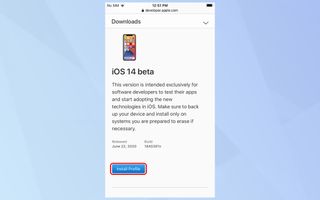
Our usual advice about Apple’s betas remains in effect for iOS 14. While Apple generally releases pretty stable betas, they still feature bugs and showstoppers that could interfere with running the apps you rely on. We suggest that if you do decide to install the iOS 14 beta, you do so on a spare device — one that you don’t depend on for everyday use. Betas generally get more stable with subsequent updates, but using a spare iPhone initially can save yourself any beta-induced headaches.
If you’ve decided to take the plunge, here’s how to get the iOS 14 beta. For the developer version, you’ll need to be a member of Apple’s developer program, which costs $99 a year. If you’re part of the program, head to the Apple developer website on your iPhone and select Downloads. From there, find the iOS 14 beta and tap Install Profile. You’ll need to go into the Settings app on your phone to install the beta profile, which will cause your iPhone to restart. From there, it’s just a matter of updating the software like you regularly would.
It’s probably easier just to wait for the public beta, which is coming in July. You can enroll now in Apple’s beta program so that you’re ready when iOS 14 arrives. The installation process is similar to what developers go through — install the beta profile, then update your iPhone. We’ll have more specific directions when the public beta becomes available.
iOS 14 iPhone compatibility
Apple is usually generous with which devices can run its latest software, and that continues with iOS 14. If your current iPhone runs iOS 13, you’ll be able to upgrade to the new OS, with the iPhone 6s, iPhone 6s touch and the original iPhone SE all able to support iOS 14. That means devices released as long ago as the fall of 2015 will be able to upgrade come the fall (or sooner, if you’re a beta tester). And of course, iOS 14 will run the iPhone 12 as well.
In addition to all iPhone models since the iPhone 6s, iOS 14 works on the seventh-generation iPod touch. As for the iPad, Apple’s tablet has had an OS of its own since last year, even though iPadOS and iOS share many features. iPadOS 14 will appear in public beta form in July, too, with a final version also slated for the fall.
iOS 14 features
iOS 14’s new look may be the most noticeable change, but it’s far from the only new feature you’ll find on your iPhone this fall. Enhancements in iOS 14 span everything from a faster, lighter way to quickly access apps for short-time use, to a powerful new translation tool, picture-in-picture video, new information relevant for cycling in Maps and much more.
Here’s a deeper dive into all of iOS 14’s new capabilities and design tweaks.

By far the most revolutionary change with iOS 14 is what Apple has done to the home screen. A new App Library page serves as iOS’ take on Android’s app drawer, except it intelligently groups apps based on category. Widgets can be resized and lifted out of their own page onto normal pages right alongside apps on the home screen.
These widgets are far more extensive than anything Apple has ever put into a previous iOS edition. The weather widget can be resized, for example, to take up four columns or two, and each change in size dynamically adds more information, like a week-long forecast.
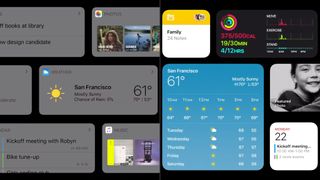
There’s also a new separate class of widgets called Smart Stacks. Essentially, a Smart Stack is like a dynamic widget that acts as a widget for a certain app based on contextual cues, or depending on the time of day. When you wake up, for example, your Smart Stack might show the weather. A couple hours later, perhaps the calendar. And when you get home, it’ll change again to display your fitness metrics. You can also manually swipe through all the apps included in your Smart Stack whenever you like.
For a closer look at all the changes coming to the iPhone’s iconic interface, be sure to check out our deep dive into how Apple has revolutionized the iOS 14 home screen.
iOS 14: App Clips
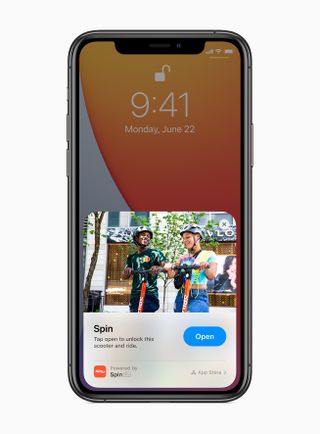
You won’t need to download apps just to use some features in iOS 14. Instead, App Clips are small, downloadable snippets that handle specific tasks like paying for parking or ordering from a food delivery service. App Clips works with the existing Sign In with Apple feature to spare you from having to create login information, and payment tasks can be handled via Apple Pay.
iOS 14: Messages and conversations
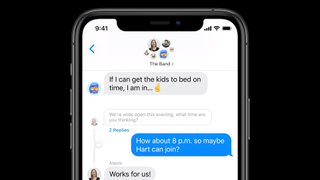
Messages has remained largely unchanged over the years, but it’s finally getting some added functionality with iOS 14. Outside of the requisite additions of new Memojis (there’s a face mask accessory now, unsurprisingly), the new Messages list screen provides a space at the top for you to conveniently pin contacts you talk to most frequently.
The other big upgrade pertains to group conversations. Now, you’ll be able to respond to a specific reply, sort of like how you can on workplace apps like Slack. And anyone who has ever been included in a massive iMessage group will appreciate the new option to turn off all notifications in a particular group conversation unless a member of the group pings you specifically.
iOS 14: Siri and translation

It seems like Apple is always promising new improvements to Siri with every iOS update, but iOS 14 might deliver on that promise.
Apple is going with a compact design for Siri. Instead of pulling up a separate Siri screen, you can tell the digital assistant just to launch an app, and it will do so directly from the home screen. Similarly, Siri requests like the weather will appear at the top of the screen.
With iOS 14, Siri will be able to do on-device dictation, so that your words stay on your device. Google Pixel owners can tell you how welcome that feature is. And Apple is boosting the translation powers of Siri to support conversations and not just snippets of translated phrases.
To that end, a new Translate app in iOS 14 will let you translate entire conversations right on the screen of your iPhone. Turning your phone into landscape mode creates a split screen with the conversation displayed in different languages on either side of the screen.
Translate is smart enough to automatically detect the language, Apple says. And all that translating and transcribing happens on the iPhone without any data being uploaded to the cloud. That means you won’t need an internet connection to converse with someone in another language, and the translation will be faster than ever before.
At launch, Translate will support 11 languages: English, Mandarin Chinese, French, German, Spanish, Italian, Japanese, Korean, Arabic, Portuguese and Russian. Translation will also be possible within Safari for the first time ever.
iOS 14: Picture-in-picture video

Phone screens are getting so large, you’d think Apple would have introduced a picture-in-picture video feature in iOS 12 or 13. Thankfully, the company is finally catching up with the times. You’ll be able to watch video while you’re in other apps on iOS 14, and the interface to do it is quite clever.
Videos will live in tabs to the side of the display that can be dragged out or tucked back in depending on when you actually want to see them. Videos can also be resized, which is really handy if you’re working on a task that requires most of your available display real estate.
iOS 14: Maps

Apple has several changes planned for Maps, including new Guides. The idea behind Guides is that Apple will give you curated recommendations for places to eat and locations to explore in select cities. However, the more exciting addition to Maps involves helping you get around in ways that minimize your carbon footprint.
In iOS 14, you’ll be able to get cycling-specific directions that will alert you to bike lanes and paths. Your directions will let you know if you’ve traveling down quiet or busy roads, and you’ll also get a glance at the elevation on your route to warn you if there are some steep hills ahead.
If you’ve got an electric vehicle, Maps will add an EV routing feature that tracks the current charge of your vehicle. Your map will then display charging stations along your route, with Maps taking elevation and weather into account.
iOS 14: CarPlay and car keys
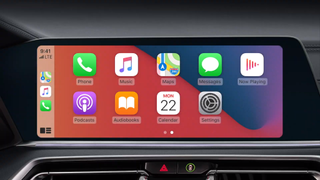
If you’re sick of lugging around physical keys, Apple has an alternative in iOS 14 with car keys in the Wallet app. Car keys use NFC, and you simply tap to unlock your vehicle. In some models, you’ll even be able to place your iPhone on the vehicle’s interior charging pad and then just press the ignition button to start the car.
Apple says its car keys feature is more secure than physical keys. And you can share keys with other iPhone users securely, thanks to the Secure Enclave embedded in Cupertino’s handsets. The first vehicle to support car keys in Wallet, the 2021 BMW 5 Series, will be available in July, though more will eventually follow.
Apple says that it is working with carmakers so that you’ll be able to keep your phone in your pocket or bag and still use your phone as a car key. New wallpaper options are also coming for CarPlay. And once again, Apple is adding useful tools for drivers of electric vehicles, like the ability to track your car’s charge level, and predict how long it will be able to run while taking factors like elevation into account. This functionality will exist within the normal Maps app, though it figures to be especially useful in tandem with CarPlay inside your vehicle.
iOS 14: Privacy features
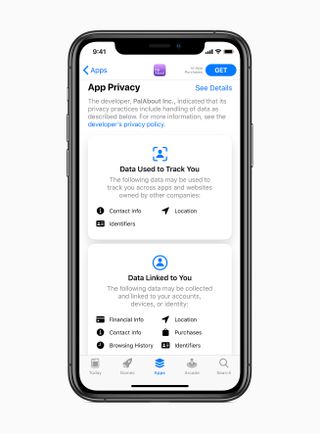
Apple’s iOS 14 includes some privacy features designed to give you more transparency and control. For instance, all apps are now required to obtain user permission before tracking them. Apple also says that App Store product pages will feature summaries of developers’ self-reported privacy practices in an easy-to-understand format.
Sign in with Apple is getting an upgrade, too, in iOS 14. Users will be able to upgrade their existing accounts to Sign in with Apple to better protect their privacy. You can also choose to share your approximate location instead of your precise location when asked for access.
iOS 14: Home app and HomeKit

One of the flashiest additions to the Home app is that video cameras and doorbells that work with HomeKit will be able to recognize people you’ve tagged in iOS 14’s Photos app. But other enhancements include a redesigned visual status that prioritizes accessories most in need of your attention along with suggested automations when you set up a new HomeKit-compatible device.
Another highlight for the Home app in iOS 14 is expanded controls in Control Center for quicker access to accessories and scenes. And Adaptive Lighting will automatically adjust the color temperature throughout the day for HomeKit-enabled lights.
iOS 14: Health
Apple is punching up iOS 14’s sleep tracking capabilities with iOS 14, by encouraging you to set sleep goals, recommending a bedtime and giving you the option of setting ideal sleep patterns for certain days of the week. iOS 14 will also be able to tell you how your listening volume preferences might be harming your hearing over time.
A new Checklist menu makes it easier to manage your data, while new metrics for mobility, medical records, symptoms and ECG allows you to establish a more complete understanding of your health.
iOS 14: Other helpful features

Back Tap: Back Tap is a new accessibility feature in iOS 14 that lets you double tap or triple tap the back of your iPhone to perform various tasks or shortcuts. You can do everything from take screenshots and launch specific apps to even turning on all the lights in your house.
Camera and Photos improvements: Apple promises that phones running iOS 14 will have a faster time to not only the first shot but also shot-to-shot performance. The Camera app adds an exposure compensation control to lock an exposure value while also locking camera focus on specific shots, while Photos adds new filter and sort options.
New AirPods features: iOS 14 includes a big update if you’ve got a pair of Apple’s AirPods Pro. The new OS adds support for spatial audio, which can recreate a movie theater sound experience in your ears. Regardless of whether you own the Pro version of AirPods or not, iOS 14 supports automatic switching so that when you finish a call on your iPhone and go to watch a movie on another Apple device, you’ll be able to switch your AirPods connection seamlessly.
Default apps: Tired of using Safari and Mail as your default browser and email apps? In iOS 14, you’ll be able to designate third-party apps as your defaults for the first time, so that links to open your browser won’t automatically point you toward the Apple versions you don’t want to use.
Streamlined call alerts: Getting a ring? Instead of overtaking your entire iPhone’s display, as it does now, incoming calls will be conveyed like alerts, at the very top, if you happen to receive a call while doing something else. It’s lighter, less intrusive and simply makes more sense.
iOS 14 outlook
Even with the iOS 14 preview we’ve seen, there are still some features that could become more evident this fall — especially in relation to features that may appear in the iPhone 12 models. While Apple didn’t spend much time talking about augmented reality during the WWDC keynote, there is a new version of ARKit in iOS 14 that includes new developer tools for more immersive AR experiences. Those could definitely be of interest to the iPhone 12 Pro models, which are rumored to feature LiDAR sensors like the one added to the iPad Pro this year.
Similarly, there was no mention of AirTags, the rumored tracking hardware that will likely work with the FindMy app in iOS 14 and the U1 chip on newer iPhones to help find keys and other lost objects.
But there’s a lot of time between now and the fall release of iOS 14, and a lot of iOS 14 beta updates to play around with. Stay tuned for more iOS 14 revelations as we get a chance to spend more time with Apple’s mobile OS update.

